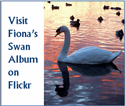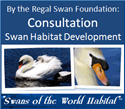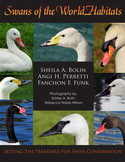Ask the Swan Specialist
Date: 7 November 2012
Winter weather is just around the corner. We are frequently asked what to do with captive swans that cannot migrate from the cold and wind. We recommend that a small shed or garage be used, but in most cases, trying to capture a swan or several swans and house them for the winter may not be practical. However, keeping swans on a frozen lake can mean eventual death due to drowning, starvation, pneumonia and predation.
If swans are being kept on a pond or lake that can freeze, we strongly recommend some type of habitat addition such as an island or other barrier which can withstand heavy winds and help protect the swans from the wind. Additionally, a de-icer is a MUST for any pond or lake that has the potential to freeze. It is for these reasons that I am asking our two sponsors: Bob Knox from Knox Swans and Sue Cruz from Vertex Water Features to help answer questions regarding the best type of habitat protection and de-icing equipment for a swan winter habitat. Should you need further assistance, please do not hesitate to contact these two great resources. They are very knowledgeable and above all CARE ABOUT THE HUMANE TREATMENT OF SWANS! The Regal Swan
How do you protect swans from cold winter winds if you cannot bring the swans in during the winter?
Bob (Knox Swans): For heavy winds, one could plant tall grasses or small evergreen type shrubs. Plant them close enough together to block the wind. Otherwise, build up a berm of soil on one side to protect the swans from the wind. I have tall prairie grass planted in my pens for nesting and shelter from the wind. It can also withstand cold temperatures.
Evergreen shrubs such as Arborvitae are used to hide the pens and protect the swans from cold winds. I use heavy gauge chain link fence to protect the swans from predators and fence along the ground to help protect the swans from predators digging under the fence. To protect nesting swans in the spring which can still be somewhat cold, I use floating islands made of wood. I can get away with 4’x4’ square islands. In this case, I would say slightly larger would be better, but my Mutes can and have all used the 4’x4’ islands.
Why should an aerator/de-icer be used for a pond or lake?
Sue (Vertex Water Features): Good water quality is key to having a diverse and healthy aquatic ecosystem. There are two conditions that are necessary for a healthy lake or pond; 1.Sufficient oxygen and 2.adequate mixing of the water to reduce stratification so that the oxygen is uniformly distributed throughout the water column. Dissolved oxygen is not only used by fish, vegetation, and other organisms, but it is also essential in the oxidation and bacterial digestion of suspended organic material and bottom sediments.
There are several reasons for winter pond aeration: to increase oxygen levels in order to prevent winter fish kills, keep open areas of water for winter water fowl and other wildlife, or to prevent dock or boat damage. Winter waterfowl seek out areas of open water for a number of reasons, most importantly to rest while protected from predators. Other wildlife seek out areas of open water in order to drink, and because their prey will likely be there too.
Under ideal conditions, natural forces can keep a lake healthy and aesthetically attractive, but unfortunately our lakes do not exist under ideal conditions. Water mixing and movement is restricted. In the summer months, hot, hazy and cloudy days worsen the situation because of lack of photosynthesis and the fact that warm water holds less oxygen. Rain and irrigation water runoff carries organic debris, nutrients and other chemicals that consume oxygen. Toxic algae blooms, harmful bacteria and avian botulism are directly related to poor water quality and can be prevented through proper aeration.
An effective aeration system brings oxygen into the water, eliminates stratification and increases circulation. This makes the water at all levels able to support animal and plant life, control algae growth by limiting its food source, and aid decomposition of suspended organic material and muck on the bottom of the lake. Along with the benefits of healthy and clean water, aeration systems also will keep ice open on a pond in the winter, making a safe environment for your swans. The size of the opening in the ice depends upon depth, air temperature and air flow. Depending on the number of swans you have and how much ice you want to keep open, Vertex makes a variety of AirStations with multiple diffuser disc assemblies and different size cabinets and compressors to fit your needs.
What is the adequate size pond or area of unfrozen pond needed for 1-6 swans
Bob (Knox Swans): I always try to keep at least a 15' diameter opening in the pond during winter time.
What size aerator/de-icer do I need?
Sue (Vertex Water Features): Vertex Water Features manufactures pond and lake aeration systems for any size body of water. We always recommend that pond owners or managers contact us directly so we can assist them with selecting the proper aeration system. Each pond or lake is different as are the goals of the owner, so there is no “one size fits all” aeration system. Climate, owner’s goals, water quality, fish species as well as pond/lake depth, shape and size are just some of the considerations that make up proper aeration sizing.
Once a Vertex Aeration System is recommended, pond owners can purchase the equipment through a qualified Vertex dealer either locally or online. Most systems can simply be shipped FedEx Ground are all are ready to take out of the box and plug in. Most aeration systems are available in 115V or 230V and can either be installed by the pond owner or by a local distributor.
Are there any special maintenance requirements for those individuals who presently have aerators/de-icers during winter months?
Sue (Vertex Water Features): Operating in freezing conditions on an ice-covered lake causes large open water areas to remain at the boil sites. Warning: ice thickness around these open areas is thinner than the ice over the remainder of the lake. Injury or fatality may result from people, snowmobiles, etc. falling through the ice. Vertex strongly recommends that this danger of thin ice around the boil area be clearly posted at frequent intervals. Owner assumes all responsibility for operating Vertex aeration systems during winter months.
AirStations™ should be moved to a shallower portion of the waterway (1/2 the depth of original placement) until warmer temperatures return, to allow warmer water to remain in the lower regions of the waterway and prevent water column freezing.
Along with owning swans comes the responsibility of maintaining a safe and healthy environment. You owe it to your feathered friends to protect them year-round.
Vertex Water Features: http://www.vertexwaterfeatures.com
Bob Knox Swans: http://www.canadiangoosecontrol.com
Ask the Swan Specialist is powered by
Tetra-WebBBS 5.30 Beta © 2006-2007 Tetra-Team






